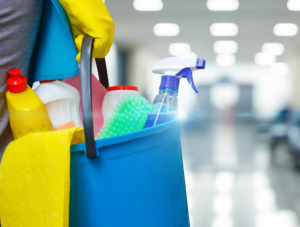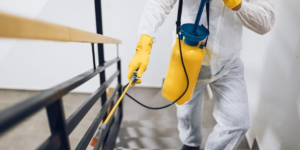Cleaning Services provide a variety of services for homes, businesses, and institutions. They can clean floors, wash windows, dust furniture and knick-knacks, and more.
A clean home or office can reduce stress and promote well-being. It is essential for a professional image and increased productivity. Here are some tips for choosing the right cleaning service for your needs. Contact All Pro Services now!

Commercial cleaning services specialize in providing cleaning services for businesses and commercial spaces like office buildings, departmental stores, malls, restaurants, food establishments, and healthcare and medical facilities. These spaces have high foot traffic and require more specialized equipment and cleaning methods to maintain their cleanliness and hygienic standards. Unlike residential spaces, these commercial spaces have to meet stringent public health and safety regulations. Failure to do so can result in fines and even closure of the business. This is why regular commercial cleaning and sanitizing are essential for these types of business establishments.
Commercial cleaners provide general janitorial and deep cleaning services to businesses of all sizes and types. They offer a wide range of tasks including dusting and mopping floors, trash removal, window washing, wiping down surfaces and equipment, and sanitizing kitchens and bathrooms. They also clean and disinfect rooms and spaces that are frequented by customers or employees such as the reception area, conference room, and breakrooms.
In addition to the usual janitorial and cleaning services, some commercial cleaning companies also provide more specialized and extensive services such as carpet cleaning, floor stripping and waxing, upholstery cleaning, and exterior window washing. They can also take care of hazardous waste disposal and pest control. They are also familiar with the different cleaning requirements for each industry and type of facility.
Professional commercial cleaners have specialized training and experience in handling the many facets of commercial cleaning. They are often licensed and insured and are familiar with the latest sanitization and disinfection procedures, equipment, and products. They can also handle special requests and unique situations that may arise in the workplace.
In addition, they have the necessary skills and knowledge to use a variety of heavy-duty cleaning equipment that is usually too expensive for offices or small businesses to purchase themselves. This includes HEPA vacuum cleaners, industrial steamers, and specialty surface cleaners for hard surfaces like marble and hardwood floors. Additionally, they know which cleaning products and solutions work best for different types of materials and surfaces, such as glass, stainless steel, concrete, and tile. They are also familiar with the different environmental and occupational health and safety standards that apply to the cleaning industry, such as OSHA and EPA guidelines.
Residential Cleaning
Residential cleaning services focus on the upkeep of homes and apartment buildings. The work of a residential cleaner may include dusting, vacuuming, mopping, and cleaning bathrooms and kitchens. This type of service is essential for homeowners as it contributes to a hygienic living environment and can increase the value of a home.
When starting a business in this sector, you need to consider the costs of equipment and employees. In addition, you will need to meet health and safety standards. These standards vary by state and municipality, so it’s best to check with the local authorities for the specific requirements for your area.
You should also think about the number of clients you can expect to have and their preferences for how often you clean their homes. Some clients may only require you to come twice a week, while others might need your services once or more per month. As a result, the amount of money you can make from your residential cleaning company will differ depending on the needs and budgets of your clientele.
One of the biggest differences between commercial and residential cleaning is that the former requires a much higher level of training and professionalism. This is because the cleanliness of a commercial property is a lot more visible than that of a private residence. In addition, commercial cleaners are typically required to be bonded and insured in order to protect themselves from liability in the event of an accident or property damage while they’re working on site.
Residential cleaners, on the other hand, are not bonded or insured. As a result, they are at greater risk of accidents or property damage while they’re working on clients’ homes. For this reason, it’s important that you hire residential cleaning contractors with excellent communication skills and a high level of professionalism.
Another difference is that a residential cleaning company will usually have more interaction with their clients than a commercial cleaning business does. This is because the clients of a residential cleaning company are in their home while the cleaners are working, so they are more likely to watch what the cleaners do and ask questions if needed. As a result, it’s important for residential cleaners to be punctual and polite at all times.
Industrial Cleaning
Industrial cleaning services involve specialized techniques and equipment for large-scale areas like power plants, factories and warehouses. These places often contain heavy machinery, chemicals and other dangerous materials that must be handled carefully to avoid safety risks. Regular cleaning by an industrial cleaner helps to reduce the risk of accidents or equipment failure that could cost the company tens of thousands in repairs.
The types of cleaning services provided by an industrial cleaner include deep cleaning, surface preparation and disinfection, waste disposal and more. The goal is to keep the workplace clean and healthy for employees, which can help increase productivity and overall business performance. For example, medical facilities must meet a high standard of cleanliness to prevent the spread of disease and ensure the safety of patients. Warehouses need to be kept free of debris and contaminants to protect inventory and improve efficiency.
When choosing an industrial cleaning service, it’s important to find one that is licensed and insured. They should have workers’ compensation and general liability insurance to cover any injuries or property damage that may occur during the cleaning process. Ask to see proof of these insurance policies before hiring the company.
Also, look for an industrial cleaning service that specializes in hazardous waste removal and management. This is especially important when working with dangerous materials, as a mistake during the cleaning process can be catastrophic. Using an industrial cleaning service that is certified in hazardous waste removal will give you peace of mind knowing that the company is following strict safety and environmental regulations.
Finally, choose an industrial cleaning service that offers a range of services and can customize their approach to fit your needs. For instance, some companies specialize in sanitizing sensitive areas such as laboratories and data centers where the air quality must be perfect to avoid contaminating delicate electronic equipment. Others offer services that are more general in nature, such as pest control, high-level cleaning, removing mold and allergens, and waste disposal.
Environmentally Friendly Cleaning
In an effort to protect human health and the environment, eco-friendly cleaning services use non-toxic and natural products. These cleaners are also biodegradable, avoiding the harmful environmental impact of conventional chemical-based cleaning products. Eco-friendly cleaning services can provide homeowners with a wide range of benefits, from reduced indoor air pollution to improved safety for their children and pets.
Harsh chemicals used in traditional cleaning products can release volatile organic compounds into the air. These compounds contribute to poor indoor air quality, increasing the risk of respiratory problems, allergies, and skin irritation. Green cleaning services use natural, non-toxic ingredients that are safe for everyone, including pets and kids.
Environmentally conscious consumers are increasingly seeking out cleaning services that prioritize sustainable practices. These services minimize waste, reduce water and energy usage, and promote responsible product disposal. While the upfront cost of these services might be slightly higher, they can save money in the long run by reducing wear and tear on furniture, carpets, and other surfaces.
Homeowners should ask potential cleaning service providers for details about their environmental initiatives. Specifically, they should ask about the company’s cleaning products and ingredients. Look for certifications such as Green Seal and the EPA’s Safer Choice label to ensure that the cleaning products are both effective and safe for human health.
While implementing environmentally friendly practices may require some initial investment, these investments can help to reduce costs and improve customer satisfaction. For example, implementing paperless communication and promoting recycling programs can cut down on office expenses while reducing the amount of waste produced.
Adding an eco-friendly cleaning option to your service offerings can attract environmentally-conscious clients who might be willing to pay more for a premium service. Additionally, you can donate a portion of your profits to environmental nonprofit organizations.
Ultimately, green cleaning services can have a significant impact on the planet. By limiting their chemical exposure and using sustainable practices, these services can significantly reduce their carbon footprint. They can also help to protect our health and well-being, making the Earth a better place for future generations.








